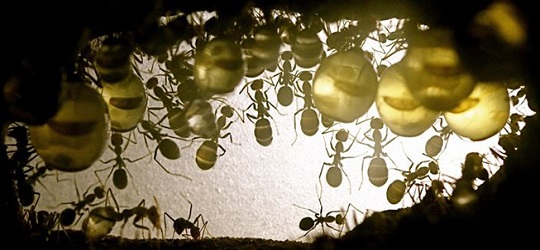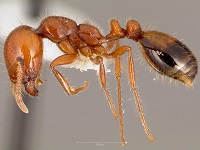Honey-Pot Ants
In nests of honey-pot ants, living food jars up to about half an inch across cling to the ceilings of underground cavities. On the surface, they are best recognized by their erratic, stop-and-go movements.
As with most types of ants, adult workers feed immature larvae by regurgitating liquid food. Honey-pot species take that two steps further. Workers forage outside the nest for plant juices and other foods, then feed sweet liquid to a specialized group of adult workers called "repletes." The repletes swell into berry-like spheres to store honey for sustaining the colony through the lean season. They hold up to eight times their body weight in honey, but can barely move.

Ant fan Ray Mendez savors them on crackers. "The flavor depends on what the foragers eat," said Mendez, who keeps a honey-pot ant farm in his southeastern Arizona home. "When we give them apples to eat, they taste just like apples," he said.
Seed Harvesters
Pictured below to the right are seed harvesters found in back yards and deserts. The two, formerly cooperative foundresses of the ant species Messor pergandei, are engaged in lethal combat.

Such fights begin soon after the first adult workers appear in the nest and result in the demise of all but one of the original foundresses.
"Pogo" workers grow to about half an inch and range from red to black. They forage up to about 100 feet from their nests, which are conspicuous bare-soil circles with a central opening.
Queens may live more than 20 years, continuing to lay eggs from a single mating flight. But once individual workers begin foraging outside the nest, lizards, birds, dehydration or other hazards are likely to kill them within a month. Younger workers are continually tending new batches of eggs. As workers get older, they become expendable foragers instead of larva-tenders.
Tens of thousands of ants may cooperate as a single colony. Winged reproductive forms, males and virgin queens, fly after summer rains. After mating, the males promptly die and the queens try to start their own colonies. A tiny percentage succeed.
Desert Fire Ants
These shiny ants, either black or red, are common in yards and pack a nasty sting. Most are only about one-eighth of an inch long.

The Arizona Department of Agriculture has so far been successful at keeping Arizona free of the local fire ants' South American cousins, red imported fire ants, which have infested states from Florida to Texas.
Slave Makers
The sickle-blade jaws of slave maker ants aren't good for feeding their own young, just for killing other ants and stealing their babies.
A newly mated slave maker queen rushes a nest of another species of ants. Often, that colony's workers kill her before she gets to their mother. If not, she kills their queen, then rubs herself with the scent from the dead queen. Then the workers act like she's their mother, and tend the eggs she lays and the larvae they hatch into. When those larvae mature into slave maker workers, they raid other colonies. They kill the adults and bring home the eggs and young to keep up a supply of slaves in their mom's colony.
Army Ants
Army ants attack other ants' nests not to steal babies, but to eat them. The ones in and around the Valley are nearly blind. Tens of thousands of them may form raiding columns during nighttime raids, eating whatever other insects they come across. An Army ant colony does not build a permanent nest. It moves as a group from place to place to find new food supplies, using temporary shelters such as rodent holes.
Read more about: Ants
Bibliographic details:
- Article: Arizona Ant Species
- Author(s): Dr. Biology
- Publisher: Arizona State University School of Life Sciences Ask A Biologist
- Site name: ASU - Ask A Biologist
- Date published: 7 Jan, 2010
- Date accessed:
- Link: https://askabiologist.asu.edu/arizona-ant-species
APA Style
Dr. Biology. (Thu, 01/07/2010 - 08:33). Arizona Ant Species. ASU - Ask A Biologist. Retrieved from https://askabiologist.asu.edu/arizona-ant-species
Chicago Manual of Style
Dr. Biology. "Arizona Ant Species". ASU - Ask A Biologist. 07 Jan 2010. https://askabiologist.asu.edu/arizona-ant-species
Dr. Biology. "Arizona Ant Species". ASU - Ask A Biologist. 07 Jan 2010. ASU - Ask A Biologist, Web. https://askabiologist.asu.edu/arizona-ant-species
MLA 2017 Style
Be Part of
Ask A Biologist
By volunteering, or simply sending us feedback on the site. Scientists, teachers, writers, illustrators, and translators are all important to the program. If you are interested in helping with the website we have a Volunteers page to get the process started.


